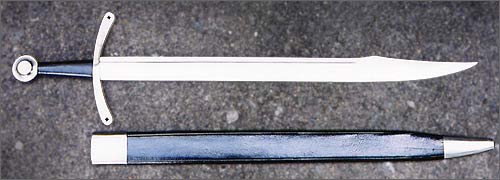
 |
|
|
Windlass Steelcrafts German Falchion
A hands-on review by Sean A. Flynt Having been very satisfied with recent purchases of Windlass Steelcrafts items, I took a chance on their inexpensive Falchion (pronounced FALL-shun), and found it to be surprisingly well done. As usual, ordering from Windlass Steelcrafts vendor Museum Replicas Limited (MRL) was quick and pleasant. Overview Anglo-Europeans were not the first people to recognize the merits of a broad, short, single-edged and relatively heavy cutting blade, but they seem to have taken up such weapons with enthusiasm. Their culturally distinctive, but functionally consistent, falchions, stortas and messer are often depicted in the hands of both infantry and cavalry in medieval and renaissance artwork. Unfortunately, vital statistics for, and accurate replicas of, these weapons are almost as scarce as surviving examples. In The Archaeology of Weapons, Ewart Oakeshott described one these weapons, the Thorpe Falchion, as one of a group of four East Anglian swords which share almost identical pierced quillons of Oakeshott Type 6. He noted that the relatively narrow blade of this weapon, the only falchion in the group, was unlike earlier English falchions (of which the Conyers Falchion is best known) and might have been influenced by saber-like Eastern European blade forms. Whatever the blade's stylistic origins, Oakeshott identified the Thorpe Falchion as an English weapon of the late 13th or early 14th century.  Alan E. West, Curator of Archaeology for Norfolk Museums and Archaeology Service, has generously provided the following additional information about the Thorpe Falchion. I've added inch and pound conversions in parentheses. Measurements and Specifications of Original:
Blade notes: Single fuller of 1.5-2mm (.05"-.07") width runs 5mm (.19") parallel to back of blade on one side of the blade only. False edge appears to have same bevel as true edge. Mr. West noted that the grip is missing and the blade edge shows "numerous notches," while the back of the blade is in better condition. He said the pommel is brass with engraved images of animals and monsters. As for provenance, West said the falchion was dredged from the River Yare at Thorpe St. Andrew in 1833 and has been in the collection of the Norwich Museum (now Norwich Castle Museum) since that time.  Now compare the original's vital statistics to those of the Windlass Steelcrafts Falchion. Measurements and Specifications of Reproduction:
Replica created by Windlass Steelcrafts of India. Blade notes: Single fuller of 2.5mm (0.09") width and 475mm (18.7") length runs 8mm (0.31") parallel to back on both sides of blade. False edge is flat/unbeveled. Although this replica is marketed as a "German Falchion", it clearly is at the very least inspired by the Thorpe Falchion. The superficial resemblance between original and replica-the narrow blade with clipped point, distinctive pierced quillons and Oakeshott Type J wheel pommel is unmistakable, but the similarities go much deeper. Highlights of the Comparison:
Although I was surprised by the weapon's agility in a hammer grip, I found that slipping my thumb over the quillons and keeping pressure on the inside of the blade further aided my control of the weapon. That grip did not feel especially secure in strong cutting motions, however. The handling of the weapon makes me eager to investigate the bloodline that links it with the messer illustrated in Germanic renaissance martial texts. Fit and Finish The hilt furniture of this replica is very tight and well finished. I was surprised to discover that the softwood grip is of the sandwich variety, and is securely glued to the tang. The Pommel (presumably of the screw-on type) and guard also seem to be glued in place. The simple leather scabbard, with steel furniture, is sturdy but unremarkable. Blade and all hilt furniture are of brightly polished, heavily lacquered steel, but sanding and the application of vinegar and salt solution quickly gave the steel a deep gray color. Longer exposure to the solution produced the effects you see in the photos, shown here. Conclusion The Windlass Steelcrafts Falchion is a thoughtful replica of an historic weapon, and I consider it a great bargain at the Museum Replicas Limited discount price of around $155 USD (including shipping), or even at the full MRL price of approximately $185. Windlass should take credit for its achievement by citing the Thorpe Falchion as its inspiration. For further reading, Visit Björn Hellqvist's excellent discussion of the Conyers Falchion and scroll down on that page to view another illustration of the Thorpe Falchion. Also keep an eye on the Association for Renaissance Martial Arts (ARMA) Web site for a new page dedicated to this fearsome family of weapons. About the Author Sean Flynt is a public relations professional in Birmingham, Alabama. He is interested in the martial culture of all periods and people but focuses on 1450-1650, with special interest in German and Austrian arms and armour. Acknowledgements Photographer: Sean A. Flynt |